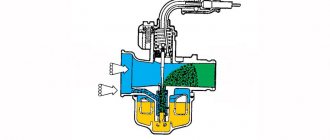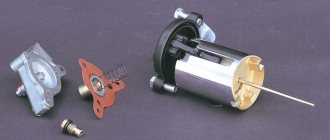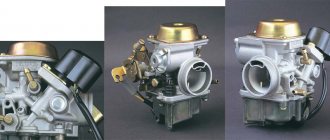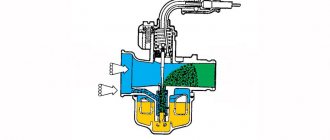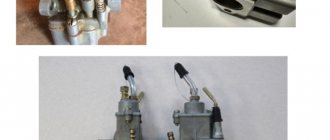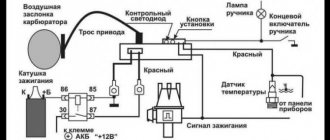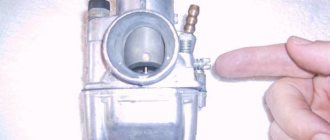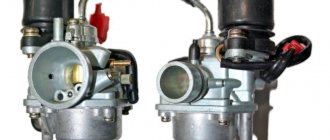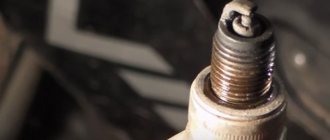To adjust the carburetor on a 125 pit bike, you first need to check the color of the spark plug. Ideally, the color of the candle should be dirty orange. The second option is more suitable for an experienced pit bike owner. When you start to let off the gas and you hear shooting, this will mean that the mixture is not of the proper quality. And if, when you sharply press the gas pedal, the engine seems to be choking and there is no correct pickup, this also means that the mixture is of poor quality.
The idle speed is adjusted using two screws: a quality adjustment screw and a quantity adjustment screw. If the quality screw is on the diffuser side, then it regulates the fuel supply, and if on the air filter side, it regulates the air supply accordingly. Initially, we set the minimum stable speed using the quantity screw, i.e. your pit bike should almost stall, then we slowly begin to rotate the quality screw. We should hear maximum revs. After the number of maximum revolutions has been found, we begin to turn the quantity screw, setting the optimal speed for the engine.
Setting up a 125cc pit bike carburetor
TABLE OF SETTINGS FOR VARIOUS ENGINES AND CARBURETTORS:
Mikuni VM 22 carburetor - standard
125 ss (yx 125, lifan 125)
standard jet (check size), quality screw unscrewed 2.5 turns, needle position 2 at the bottom (needle raised more), floats parallel to the carburetor body.
Maximum power measured on a dyno is 6.8 hp. on a wheel
main jet 105 (specify size), quality screw unscrewed 1.5 turns, needle 2 position below (needle raised more), floats parallel to the carburetor body. Carburetor Mukuni VM 26 - standard
main jet 105 (check size), quality screw unscrewed 2.5-3 turns, needle position 2 at the bottom (needle raised more), floats parallel to the carburetor body. Carburetor Keihin PE 28 (Japanese original) - data is being clarified, for now look at the settings of the analog copy OKO 28. For Daytona 150 cc and Daytona Anima 190cc, the data is known and they are indicated in the instruction manual, they will be added a little later
Carburetor OKO 28
38 small, 105 main (checked with a gas analyzer) - at idle the mixture is rich, from 2800 rpm to 4800 the mixture is correct, above 4800 before the cutoff the mixture is lean.
38 small, 110 main (tested with a gas analyzer) - up to 4800 the mixture is rich, above 4800 there are no special changes.
Maximum power measured on a dyno is 12.3 hp. on a wheel
Maximum power measured on a dyno is 10.5 hp. on a wheel
183 cc + 4 valve head (piston 63.95 mm)
40 small, 120 main
Maximum power measured on a dyno is 14.7 hp. on a wheel
Source
Cyprus 2021, New Year holidays
Lutskiy, 13 Jan 2019
We drove about 1400 km around Cyprus. In the area of the ruins and the amphitheater of Kourion, they managed to get caught in a hailstorm and get wet to the skin. We were in the mountains at an altitude of 1400-1500 m, there was snow and real ice. Rocks are falling from the mountains onto the road, and friends even pierced the engine crankcase on one of them.
» more details
How to set up a carburetor on a 125cc pit bike
To adjust the carburetor on a 125 pit bike, you first need to check the color of the spark plug. Ideally, the color of the candle should be dirty orange. The second option is more suitable for an experienced pit bike owner. When you start to let off the gas and you hear shooting, this will mean that the mixture is not of the proper quality. And if, when you sharply press the gas pedal, the engine seems to be choking and there is no correct pickup, this also means that the mixture is of poor quality.
The idle speed is adjusted using two screws: a quality adjustment screw and a quantity adjustment screw. If the quality screw is on the diffuser side, then it regulates the fuel supply, and if on the air filter side, it regulates the air supply accordingly. Initially, we set the minimum stable speed using the quantity screw, i.e. your pit bike should almost stall, then we slowly begin to rotate the quality screw. We should hear maximum revs. After the number of maximum revolutions has been found, we begin to turn the quantity screw, setting the optimal speed for the engine.
Construction of a new house - 1. From December 2021 to 2021
Lutskiy, 29 Jan 2019
- November 2016 - piles and sand filling of the site
- 2017 from spring - painting, drainage, gutters, storm drains, concreting a garage with a pit, insulating floors, window frames, starting wiring, windows.
- 2018 from spring - rough floors, wiring, window casing outside and inside, ceilings, fireplace.
2017 from January - construction of a roof box
» more details
Medium and high speed tuning
The quality screw prepares the mixture ratio at idle. Failures in operation at high modes are eliminated in other ways.
After opening the throttle valve, the fuel nozzle comes into operation. Its task is to supply gasoline to the diffuser while the scooter accelerates.
An incorrectly selected nozzle leads to deviations in the composition of the fuel mixture. During power build-up, the scooter may “suffocate”, until the engine stops completely.
The correct algorithm for tuning the carburetor at high speeds:
- cleaning internal channels from debris;
- checking the fuel level in the float chamber;
- adjusting the shut-off valve (needle) stroke;
- checking the jet's nominal value.
A sign of proper operation of 2t and 4t engines is a sharp increase in speed when the gas is opened. Any deviations from the stability of engine acceleration indicate a violation of the settings.
Signs of deviation in mixture preparation
An important indicator of the quality of fuel combustion in the cylinders is the color of the spark plug. An experienced mechanic only needs to look at its condition to understand what adjustments need to be made.
There are two characteristic colors:
- A white (grey) spark plug means the mixture is lean, the moped overheats and does not produce optimal power.
- Black with soot - excess fuel, excessive consumption.
The behavior of a scooter with an incorrect fuel mixture is specific:
- abnormal reaction to the throttle;
- pops in the muffler;
- smoke content of exhaust gases;
- noticeable decrease in power characteristics;
- sudden engine stop.
A normal moped spark plug is brownish in color. There should be no carbon deposits on it, its electrodes should be clean, without traces of melting.
Emulsifying fuel in the idle system
In the idle system, fuel is mixed with a small amount of air, which enters through a special air channel. The fuel emulsification process occurs as follows. When the throttle valve is closed and the fuel mixture is supplied only through the low idle speed hole, the fuel is mixed with air entering not only through the air channel, but also with air from under the throttle valve passing through the transition hole. As the throttle rises, the zone of maximum vacuum moves towards the nozzle of the main dosing system. In this regard, the amount of air entering the idle system through the transition hole is reduced. At some point in the throttle lift, air completely stops flowing from the transition hole, and under the influence of rarefaction, fuel begins to gush through it. At this moment, all air begins to flow only through a special air channel, the throughput of which is regulated by a conical screw.
How to adjust the carburetor on a pit bike
In order to adjust the carburetor on a pit bike. It is necessary to first determine the quality of the mixture. The quality of the mixture must meet the standard. The correct quality of the mixture must be achieved by raising (lowering) the needle. As a rule, the needle must be lowered if the mixture has a dark (black) color, and if the mixture has a very light color, then lower the needle accordingly. If it was not possible to adjust using the needle, then you need to return the ring on the needle to the position in which it was previously.
PRECAUTIONARY MEASURES.
Always wear a safety-compliant helmet, eye protection, and other protective equipment when riding a motorcycle.
Operating a motorcycle without a helmet increases the risk of serious injury or death in a crash.
Driving a motorcycle is different from driving other vehicles, including cars. Even during normal maneuvers such as turning, driving up hills, or driving on uneven surfaces, a collision or vehicle rollover can easily occur if safety precautions are not taken.
A motorcycle is a vehicle of increased danger - driving a motorcycle while under the influence of alcohol or drugs is prohibited.
Always use extreme caution and drive slowly when driving in unfamiliar terrain. Be prepared for changes in terrain conditions when operating a motorcycle.
Do not operate your motorcycle on rough, slippery or damaged roads until you have learned and gained the practical skills necessary to control your motorcycle under such conditions.
Never select too high a speed unless it is suitable for your skills and operating conditions. Always select your speed according to road conditions and your experience.
DOMOSTROYPlumbing and construction
- Thursday, December 12, 2021 1:08
- Author: Sereg985
- Comment
- Category: Construction
- Link to post
- https://firmmy.ru/
I spent a long time reading the Internet, but I couldn’t find anything useful about this carburetor. I was able to find it myself at random, although it was not at all trivial.
The quality screw is located at the front inside the cylinder. You can only get to it with a flat bat. I just took a bit from a screwdriver. The only catch is that it needs to be adjusted when the Kayo pit bike is completely warmed up, and it’s very difficult to do this without getting burned
My spark plug was very black, and when I suddenly added gas it failed. And the weakly warmed up engine with the choke closed would not start. And fully warmed up with the damper closed, it stalls. After this quality screw was turned half a turn and rolled for about 10 minutes, the carbon on the spark plug became much lighter and it became cleaner. But apparently I’ve already gone too far. So you need to twist it just a little bit at a time, then roll around and look at the spark plug carbon.
Use the quality screw to adjust the mixture: By tightening it, we lean the mixture. By unscrewing it, we enrich it.
The easiest way to check whether a pit bike's carburetor is set correctly is by the color of the spark plug. We unscrew the spark plug and look at the color of the soot: Brick-colored - the mixture is correct White - the mixture is poor Black smoked - the mixture is rich
Needle
If there is not enough fuel, then the needle needs to be raised, that is, the lock should be lowered by 1 notch. If the candle is covered with black soot or is wet, then the quality must be reduced by lowering the needle - that is, the lock must be raised by one notch.
In addition, you can determine the quality of the mixture by the sound and reaction to opening the trigger. When you let off the gas, you hear shooting noises - the mixture is lean. When the gas is sharply opened, the engine seems to choke and there is no proper pickup - the mixture is too rich. In addition, when the mixture is lean, the engine overheats and the exhaust pipe becomes red-hot.
Category: Uncategorized
Reviews (6) on “Carburetor adjustment, mixture quality screw, photo. Pitbike KAYO CRF801-7L >
There was almost no soot on the candle. Unscrewed 1/4 turn quality
The easiest way to check whether a pit bike's carburetor is set correctly is by the color of the spark plug. We unscrew the candle and look at the color:
- Brick color - the mixture is correct
- Whitish - poor mixture
- Black smoked - rich mixture
In addition, you can determine the quality of the mixture by the sound and reaction to opening the trigger. When you let off the gas, you hear shooting noises - the mixture is lean. When the gas is sharply opened, the engine seems to choke and there is no proper pickup - the mixture is too rich. In addition, when the mixture is lean, the engine overheats and the exhaust pipe becomes red-hot.
Having determined the quality of our mixture, we begin to turn the carburetor. In reality, it looks something like this: first we try to achieve the desired mixture by raising or lowering the needle one or two notches, we try to ride it, if the difference is felt immediately, we continue to conjure until the desired result is achieved. Don't forget about the suction. The carburetor must be adjusted with the engine warm and the choke closed. If the difference is not immediately visible, we ride longer, then evaluate the results of the adjustment by the color of the spark plug. If you can’t adjust the needle, then return the locking ring on the needle to the middle position (default) and select the jets. The carburetor must be supplied with a set of jets of different sizes. The nozzle has two sizes: the first is the thread diameter (m5, m6, etc.), the second is the throughput of the nozzle in cm3/min (the numbers are stamped on the nozzle itself). You can change the jet or check its size by removing the carburetor from the pit bike, draining all the gasoline from it and opening the float chamber by unscrewing two bolts. The jet looks like a flathead screwdriver bolt with a through hole in the middle.
Accordingly, if the mixture is lean (the spark plug is white, the pipe is red, the motor is overheating), we raise the needle; if that doesn’t help, we increase the jet (the numbers are larger). If the mixture is rich (the spark plug is black, when the gas is opened sharply), we lower the needle; if that doesn’t help, we reduce the jet (the numbers are smaller). After you have adjusted the mixture, there will also be a bolt with a spring on the carber that is responsible for idle speed. If the pit bike stalls when the gas is released, the engine speed is too low - turn the screw clockwise (tighten it). If, on the contrary, the pit roars while standing on a stand, unscrew the screw counterclockwise. Ideally, do everything with the engine warm and running, so that you can immediately determine whether we have cranked up enough or whether we need more.
It happens that no adjustment helps, or this may be due to dirt and sand getting into the carburetor. Flushing and blowing all the channels in the carburetor will help here.
In general, this is how everything is set up, the main thing here is to stock up on time and patience, in this matter, of course, some professionalism is required, which will allow you to quickly identify the problem of a bad mixture and adjust the carburetor on a pit bike, but even without experience you can cope with this task. Although in particularly advanced cases it is better to call a professional.
Mikuni carburetor rebuild for pit bikes
SUPER ESSENTIAL UP
An ultra-intensive course on setting up carbers on a pit bike.
How to adjust the carburetor on a pit bike
In order to adjust the carburetor on a pit bike. It is necessary to remove the carburetor and filter, completely disassemble it, wash it with gasoline, and blow it with a compressor. Also rinse the filter thoroughly and dry it and apply special oil. After the manipulations are completed, we put everything in place. We test the pit bike on a flat, deserted area. The engine will need to be turned off so that the throttle position is at full. And then we unscrew the spark plug and carry out the above manipulations. We figured out how to adjust the carburetor on a pit bike. But I would like to describe in more detail about changing the jet. In order to determine whether we generally need to change the jet or not. It is necessary to unscrew the gas handle a quarter turn. This is necessary to check that the carburetor is set correctly. And then we check by sharply turning the throttle. If your pit bike does not stall, then you did everything right.
Having determined the need to change the jet, we select the correct size. Everything is simple here, for a mixture that has a dark color (rich mixture) we select a larger nozzle size. For a pale mixture (poor), select a smaller jet size.
As a result of everything, I want to highlight the three stages of setting up the carburetor on a pit bike.
Source
PLEASE READ THE MANUAL CAREFULLY.
Thank you for choosing a motorcycle of our brand!
During the production of this vehicle, all existing and current laws and regulations regarding noise and environmental impact were observed.
Before starting operation, you must carefully familiarize yourself with the structure of the motorcycle and all its controls. It is strongly recommended to treat the motorcycle with care, performing its maintenance in full accordance with the recommendations of the manufacturer. Strictly follow the maintenance regulations. In addition, it is necessary to follow the recommendations regarding breaking in the motorcycle, as well as fully comply with the recommendations for conducting a pre-ride inspection of the motorcycle and other types of maintenance.
WARNING!
Teens may not have the skills necessary to operate a motorcycle safely. Persons under 16 years of age must operate this vehicle strictly under the supervision of an adult, even after completing a training course.
The height of a teenager riding a motorcycle must be sufficient for him to touch the ground with his feet while sitting upright on the motorcycle. He must have sufficient physical strength to lift a motorcycle lying on its side.
A teenager driving a motorcycle and his parents must perfectly know the structure of the motorcycle, be able to use all the controls and know their purpose. They should also read this manual thoroughly before operating it.
To ensure your child's safety, ensure that proper maintenance is followed and that your child understands the importance of thoroughly inspecting the motorcycle before riding.
WARNING: Remember, your dirt bike is not intended for public roads.
The motorcycle of this model is intended to transport exclusively the driver.
The established restrictions on motorcycle loading and the design of its saddles do not allow for the safe transportation of passengers.
Popular Posts
Carburetor adjustment!
The easiest way to check whether a pit bike's carburetor is set correctly is by the color of the spark plug. We unscrew the candle and look at the color:
- Brick color - the mixture is correct
- White - poor mixture
- Black smoked - rich mixture
Jet
- If it gets rich, we reduce the jet by two orders of magnitude.
- If it becomes lean, we increase the jet by two orders of magnitude.
- If we are close to the target, we change the jet in the range ± 1.
- If, when you sharply apply the gas and release the throttle, the speed seems to hover at the top point for a few seconds, and then reluctantly drops, this indicates a lean mixture.
- If, when you sharply apply the gas and release the throttle, the speed drops and sags almost until the engine stalls, and then rises and levels out to idle, this indicates a rich mixture.
Screw quality
- By twisting, we lean the mixture.
- By unscrewing it, we enrich it.
- So we tighten the quantity screw, listen to the motor and count the number of revolutions. As soon as the speed starts to drop, we stop. We remember the position and twist it until it stops, counting the revolutions. So we know one limit value (for example, at 1.5 turns of the quality screw from the stop, the engine speed began to fall).
- Now we begin to twist in the other direction (unscrew), listen to the engine and count the revolutions of the screwdriver. The engine speed should first begin to rise, because we are enriching the mixture, and then begin to fall, because the mixture has become too rich. We record the number of revolutions of the quantity screw when the engine speed began to fall. Now we know the second limit value (for example, at 4 turns of the quality screw from the stop, the engine speed began to fall).
- Removing the carburetor and filter
- We disassemble the carburetor down to the screws, wash everything in gasoline, and blow out all the holes with a compressor.
- Reassemble the carburetor in reverse order, keeping it surgically clean. We unscrew the quality screw two turns, and tighten the idle screw almost all the way. The needle is in the middle position.
- I wash the filter with a special product, or Fairy, if it is just foam rubber (from a filter box), and rinse it in gasoline.
- We dry the filter and thoroughly saturate it with special oil, let it soak, and squeeze out the remainder, without enthusiasm.
- We put everything back together and install it on the pit bike.
- We put a new clean candle.
- Next, we look at the gas hose and gas filter (if installed). Kinks in the hose are not allowed. The filter should be blown freely without creating resistance.
- We check the presence of gasoline in the tank (at least 500 g.)
- After all the manipulations, we look for a deserted, flat road. Let's start a pit bike. Warming up. Using the XX screw, we lower the idle to stable. Then we go all the way in a straight line and ride at an active pace for about 5-10 minutes.
- We unscrew the spark plug and look at the insulator
- If it is ashen white, the mixture is too lean.
- If it is pale with a brownish tint, the mixture is too poor.
- If it is the color of coffee with milk, or a brick tint, the mixture is what you need!
- If it is darker (coffee with a small amount of milk), the mixture is slightly richer.
- If it is dark brown or black, the mixture is too rich.
Source
MOTORCYCLE OPERATION.
Preparing for departure.
Careful preparation and check of the motorcycle before departure is the key to trouble-free operation and prevents problems along the way.
Before leaving, you must carefully inspect the motorcycle and check:
— Reliability of fastening of threaded connections, pay special attention to fastening the steering wheel, wheels, engine and pendulum fork;
— Operation of mechanisms, lighting and alarm devices, in accordance with the requirements of the Road Traffic Regulations;
— Gas and torso handles, as well as free throttle movement, adjust or replace if necessary;
— The operation of the brake mechanism and clutch, adjust if necessary;
— Condition of tires and their pressure, availability of fuel and oil.
Before each use of the motorcycle, make sure it is in good condition and safe to ride.
Air filter inspection.
WARNING!
Before your first trip, be sure to service the foam filter element, since it is supplied dry from the factory (not impregnated with oil).
Air filter maintenance:
1) Use a screwdriver to loosen the clamp of the filter housing receiving tube;
2) Remove the filter from the carburetor body, removing the shipping mesh.
ATTENTION: Operation of the motorcycle does not imply further use of the transport net;
3) Use a special spray to impregnate the foam filter; if this is not available, you can use motor oil for four-stroke engines, for example 10W40 API SG/SH;
4) Remove the coarse foam cylinder from the filter housing, then spray or apply a small amount of oil evenly around the circumference of the filter element surface. Squeeze the filter element several times in the plane of the filter’s internal molding spring, thus uniformly saturating the entire surface of the foam rubber with oil. Excess and leaks of oil should be removed with a rag;
5) In reverse order, install the coarse-mesh foam cylinder onto the filter housing (impregnation is not required);
6) Attach the filter to the carburetor inlet pipe by tightening the clamp with a screwdriver.
Engine starting.
Never run the engine in a closed, unventilated area.
Make sure the motorcycle is in neutral before starting the engine.
Move the fuel valve to the fuel supply position. Place the motorcycle on the stand, insert the key into the ignition and turn it to the “ON” position. If there is an emergency engine shutdown button, move the selector to the “On” position. Move the enricher lever on the carburetor to the working position (up).
Engage the starting mechanism sector with the ratchet gear by lightly pressing the kick starter lever.
Press the kick starter lever sharply, but without impact. After starting the engine, you need to warm it up at low speed for 2-4 minutes, then return the enrichment lever to its original position.
A normally adjusted engine (after warming up) should operate stably at idle speed.
Running in the engine.
A new motorcycle, despite the high precision of manufacturing of its parts, must be run-in (5 engine hours, or one and a half volumes of the fuel tank) for better break-in of all rubbing parts.
It is necessary to remember: in order for the engine to develop maximum power in the future and serve longer without failure, it is necessary to very carefully follow all the rules for running it in.
— Avoid long periods of riding a motorcycle in low gears;
— Avoid operating the engine at maximum power, using the throttle no more than 2/3 of the full speed;
— During the first 5 engine hours of operation, try to avoid difficult road conditions: loose soil, clay, sand, long climbs, etc.;
— Carefully inspect the level of technical fluids and monitor the engine temperature.
